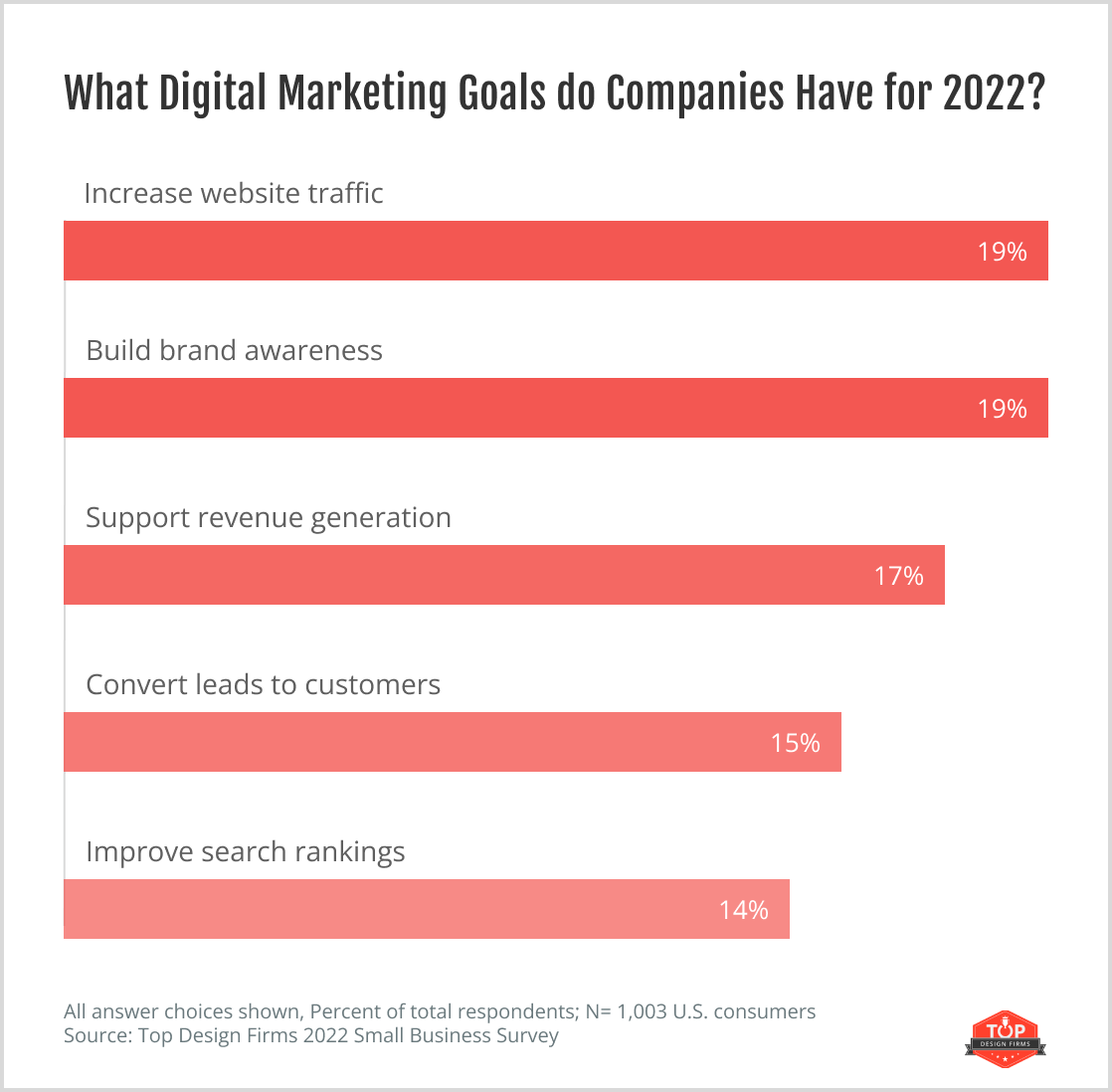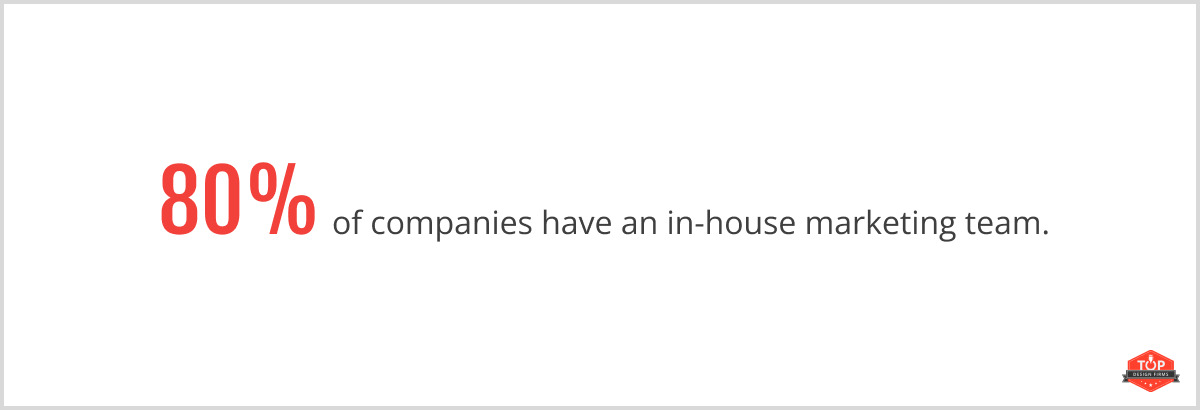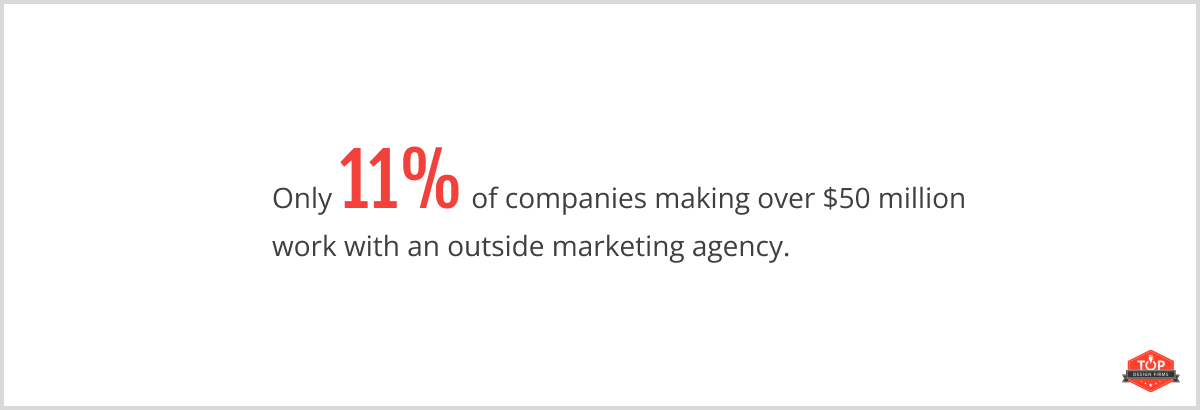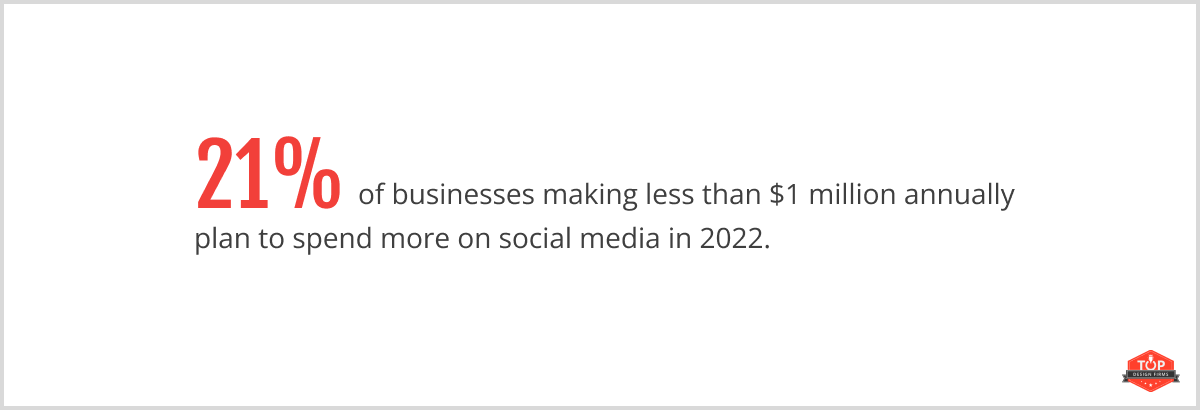2022 Digital Marketing Trends for Small Businesses
In 2022, digital marketing is a key component of any small business’s strategy. As the amount of time people spend online continues to grow, reaching your target audience online is paramount for growing your business. Learn more about how other small businesses plan to invest in digital marketing in 2022.
Think about how much time you spend online every day: every time you check your email, shop online, scroll through social media, or watch a video, you’re going online.
When this time is added up, we find that people spend hours and hours online every day. In fact, it’s estimated that the average person in the US spends 23 hours a week online or texting.
That’s almost an entire day.
In that time, they’re being exposed to ads, conducting research, and making buying decisions.
During the COVID-19 pandemic, the amount of time people spent online increased significantly and the way people made their buying decisions changed — possibly forever.
Whether you have an e-commerce business or a brick-and-mortar store, building your online presence is key to attracting these customers, growing brand awareness, and ultimately, increasing sales.
Digital marketing allows small businesses to compete with larger companies and connect with customers who may have not otherwise found them.
Top Design Firms surveyed over 1,000 small business owners and managers to get a better understanding of how companies plan to harness digital marketing to grow their business. Here’s what we found.
Our Findings
- Building brand awareness (19%) and increasing website traffic (19%) are the two most important marketing goals for small businesses followed by revenue generation (17%) and converting leads to customers (15%).
- 80% of companies have an in-house marketing team, whether that’s a team of people whose sole responsibility is marketing or work on different types of projects as well.
- Only 11% of companies making over $50 million work with an outside marketing agency and are more likely (30%) to have an in-house marketing team, showing that cost is a major factor when determining who to work with.
- Nearly half (49%) of all respondents plan to invest more in social media in 2022, largely because it is a cost-effective way to reach a large audience and grow brand awareness in a post-COVID world.
Need help selecting a company?
Based on your budget, timeline, and specifications we can help you build a shortlist of companies that perfectly matches your project needs. Get started by submitting your project details.
Brand Awareness & Increasing Web Traffic Are Priorities in 2022
When your customers see your logo on a sign, do they recognize it?
Brand awareness is how well consumers recognize your business, and it is key to expanding your audience, increasing website traffic, and building customer loyalty.
And this year, small businesses are taking notice of the benefits of growing their brand online.
Nineteen percent (19%) of small business owners and managers listed brand awareness and increasing web traffic as their top priorities in 2022, over other goals such as revenue generation and converting leads to customers.

For many small businesses, brand awareness and website traffic are closely tied. Customers that recognize a brand and trust it are more likely to visit their website and make purchases.
Ray Blakney, the Co-Founder and CEO of the online language school Live Lingua, explains how brand awareness and traffic are related and why they’re so important for small businesses, “...[C]onsumers won’t become customers if they don’t even know about the company and its offerings,” Blakney said.
At the same time, digital marketing strategies that are used to increase traffic, such as search engine optimization (SEO), can be key to growing brand awareness as well.
For example, ranking highly on search engine results pages (SERPs) has been proven to increase traffic, but it can also improve a company’s credibility and increase their visibility online, boosting brand awareness.
Sharon Terera, the founder of AfroLovely, an online business dedicated to black hair care and beauty agrees on the importance of growing website traffic but argues, “Brand awareness is equally as important [as website traffic] because it is an indicator of how well people can recall and recognize your brand, having a direct impact on the ability of your company to acquire them as a customer in the future. It is an indicator if customers are more likely to purchase products from your company rather than from your competitors.”
"Brand awareness is equally as important [as website traffic] because it is an indicator of how well people can recall and recognize your brand, having a direct impact on the ability of your company to acquire them as a customer in the future. It is an indicator if customers are more likely to purchase products from your company rather than from your competitors."
To address these issues, Terera explained that AfroLovely has developed a marketing strategy that utilizes content and SEO to boost brand awareness and increase traffic.
“We make shareable and eye-catching content, specifically infographics, that will attract new customers, be engaging, easily digestible and influence our consumers to share it with family and friends,” Terera said.
Blakney also chooses to focus on SEO, acknowledging that ranking highly on SERPs are key to attracting traffic. He explains, “Being on the first pages of Google and other high-profile search engines will help drive so many more people to the website, which in turn can lead to many more sales.”
However, there are many different digital marketing strategies that can help companies build brand awareness online and increase traffic. For some, investing in social media may make more sense than pay-per-click campaigns or vice versa.
To learn more about building brand awareness online, read, ‘6 Steps to Build Awareness Campaigns for Small Businesses.’
Need to create a brand for your business? Check out our directory of branding companies to get started on your project today.
Most Small Businesses Have an In-House Marketing Team
Digital marketing is an important tool for small businesses looking to grow their brand awareness and attract new customers. As a result, many have found the most success by bringing their marketing efforts in-house.
Eighty percent (80%) of companies have some type of in-house marketing team, whether they have a team of people whose sole responsibility is marketing, or have a few employees working on some digital marketing projects on top of their regular workload.

Tim Stumbles, the CEO of Office Timeline, a project management company, argues that in-house marketing teams have a better understanding of their company’s customers and how to appeal to them, making them more effective and well-worth the cost.
Stumbles says that, “The superior knowledge about our customers, culture, policies and products makes our in-house employees better candidates for developing effective marketing campaigns.”
Additionally, in-house teams are easier to communicate with and can be held accountable for their work.
Bringing in an outsource team can be beneficial as well, though. Stumbles explains that digital marketing agencies are great at executing textbook procedures for an affordable price.
As a result, Office Timeline doesn’t always rely on their in-house team and, instead, they partner with other teams in conjunction with their internal efforts.
“Most of our outsourced work consists of the execution of internally designed plans. Generally, outsourced professionals have greater experience in executing plans, and they prove to be more cost-effective too,” Stumbles said.
Consequently, hiring an external digital marketing team can be an affordable way to expand digital marketing efforts.
Companies with Higher Revenue are Less Likely to Hire a Marketing Agency.
For those deciding between building an internal team and hiring an outside agency, cost is a major deciding factor.
Due to the price of hosting an internal team, small businesses that generate more revenue are more likely to bring their marketing efforts in-house.
Only 11% of companies making over $50 million work with an outside marketing agency, compared to 26% of companies that make less than $50 million annually.

At the same time, companies that generate more revenue are more likely to have an in-house marketing team.
Thirty percent (30%) of companies earning more than $50 million in revenue have an in-house team, compared to 21% of companies generating less revenue than that.
This is probably because internal teams are more expensive to operate, making it difficult for smaller businesses to justify the cost.
Only 19% of companies making less than $1 million have a full-time in house marketing team. Instead, they’re more likely to hire freelancers or have existing teammates take on some digital marketing tasks.
In-House Marketing Team Vs. Digital Marketing Agency vs. Freelancer Cost
| In-House | ~$200,000/year |
| Digital Marketing Agency | $20,00–$200,000/ year |
| Freelancer | $50–$100/ hour |
It’s estimated that companies spend roughly $200,000 a year on digital marketing when they build an in-house digital marketing team. In comparison, those who hire external digital marketing agencies spend between $20,000–$200,000. Freelancers, on the other hand, cost between $50–$100 per hour.
For small companies that don’t need full-time digital marketing support and don’t plan to invest in a bunch of different digital marketing efforts, freelancers are definitely the most affordable option.
Stumbles says that, sometimes, they bring on freelancers or small digital marketing teams to work with their in-house team to supplement their work and manage costs.
This is because it is more affordable to hire external digital marketing agencies.
Email marketing, for example, can be challenging to conduct in-house because companies need extensive email lists and content management systems (CMS) to organize their campaigns. On top of that, developing an email marketing campaign can take up a lot of time and energy for existing in-house marketing staff.
Instead, small businesses can develop an email marketing plan but roll off some of the more tedious tasks such as identifying leads, compiling email lists, and segmenting audiences to external teams.
In doing so, they’re able to scale their marketing efforts while managing costs. Although full-scope digital marketing agencies can cost between $20,000–$200,000 per year, email marketing agencies only charge between $3,600–$24,000, significantly less.
In this case, it makes sense for small businesses to bring on smaller teams to work on specific projects.
SMBs Hire Marketing Agencies for Specific Services
In addition to cost, the type of digital marketing strategy a company wants to employ may affect whether or not they hire an outside partner or choose to build an internal team.
We found that companies are more likely to hire an agency for more advanced services such as SEO (50%), video (44%), and SMS marketing (43%). These services often require specialized skill sets or a deep understanding of how to use certain tools.
Other services, such as social media (37%), email marketing (37%), and web marketing (36%), are easier for companies to do on their own.
For example, developing an effective SEO strategy requires an understanding of technical SEO, which can be difficult for business leaders to implement without experience. In addition to keyword research and content generation, SEO specialists need to understand how to develop an SSL layer, create site maps, add data markups, and more.
In comparison, creating a social media profile for a business is very straightforward. Even developing robust ad campaigns on social media platforms is easy thanks to resources such as Ads Manager. TikTok for Business, for instance, boasts that businesses can launch ads in minutes.
Consequently, small businesses look to hire external teams when they need external expertise and it makes sense financially.
Small Businesses Plan to Invest More in Social Media in 2022
During the COVID-19 pandemic, the amount of time people spent on social media skyrocketed. Recent data shows that the average social media user spends two and a half hours a day scrolling through their Instagram feeds, liking posts on Facebook, or retweeting whatever is trending on Twitter.
With such a large audience, social media marketing is a great way to expand your audience and build brand awareness.
Nearly half of respondents (49%) plan to invest more in social media in 2022, in part because of pandemic-era consumer trends and it’s affordability.
Sera Chern, the Marketing Director at Virtudesk, a virtual assistant company, commented on how social media use has impacted businesses looking to connect with audiences.
“It is not new to us that a lot of studies revealed that social media users have been more active and are spending longer time browsing when the pandemic started,” Chern said.
“It is not new to us that a lot of studies revealed that social media users have been more active and are spending longer time browsing when the pandemic started.”
She expands on this to discuss the benefits of social media in marketing, “When you post about your brand on social media, you are exposing your brand to a wide variety of audiences.”
In short, social media is a great way to spread brand awareness. By creating eye-catching content, companies can drive engagement and build connections with their audience.
This is consistent with the data we collected on how companies prioritize their marketing goals.
By investing more in social media, many small businesses are able to build brand awareness and get their image in front of their ideal audience.
Social Media is a Cost-Effective Way to Expand Your Audience
Additionally, social media’s affordability is extremely appealing for companies on a budget.
In fact, it appears that the smaller the organization, the more likely they are to invest in social media marketing — 21% of businesses who make less than $1 million annually plan to spend more on social media in 2022.

In comparison, only 16% of companies making more than that plan to invest in social media, suggesting its affordability is particularly appealing.
Dan Ni, CEO of Messaged.com, an email marketing automation platform, agrees with this theory:
“[Social media] offers an affordable outlet to budget-conscious small businesses who want to get the word out about their business to their target audience in the best way possible.”
Setting up a business profile on Facebook, Instagram, Twitter, and TikTok is completely free, allowing small companies to grow their following and increase customer loyalty for next to nothing.
Still, the average organization spends between $6,000–$10,500 on social media marketing a month. This may seem like an unreasonably high number — because it is. This data is skewed because it includes costly strategies such as partnering with influencers, paid ad campaigns, developing specialized content, and more.
While large organizations may be more willing (and able) to spend tens of thousands of dollars to partner with mega-influencers like Kim Kardashian or create ads that target highly competitive keywords, small businesses have to find other strategies to increase their following.
Instead, small businesses can use more cost-effective strategies to grow their social media presence and attract sales. These strategies include:
- Partnering with nano- or micro-influencers
- Targeting local audiences
- Creating shareable content
- Repurposing content across various platforms
- Curating user-generated content with hashtag campaigns
- Posting frequently to increase engagement
While these strategies are less expensive than big PPC campaigns, they effectively build brand awareness, increase social media engagement, and positively impact online sales.
Social Media is Easy To Do on Your Own
Familiar with social media platforms, many people think that they can manage their accounts without expert support, which can help them save money as well.
Nearly two-thirds of companies (62%) that plan to invest in social media in 2022 do not work with a marketing agency.
Susannah Scheller, the technology director and coordinator for Grow Disrupt, an educational and networking resource for SMBs, understands that social media can be appealing for small businesses because they can DIY it and still get impactful results.
Scheller says, “You don't have to have a degree, or even pay any money to have a social media account. The initial look at social media marketing makes it appear as a low-investment/high-return marketing asset. Which can be true!”
“You don't have to have a degree, or even pay any money to have a social media account. The initial look at social media marketing makes it appear as a low-investment/high-return marketing asset. Which can be true!”
With an average cost of only $2.50 per thousand viewers, small businesses that plan their social media efforts well can earn a high ROI.
However, social media can be more challenging as expected because the market is overly saturated.
Scheller warns small companies trying to tackle social media marketing on their own that social media is deceivingly simple, “Small businesses truly have to be smarter than large corporations with their marketing because of their limited resources, but are often floundering and simply grabbing at the easiest marketing tool available to them: social media.”
Instead, small businesses have to be savvy in how they spend their money. Picking the right platform and targeting the right audience is key to effectively using social media to market your business.
Read, ‘Social Media Advertising 101.’ and ‘5 Social Media Tips for Small Businesses.’
Which Social Media Platforms are Worth Using?
Small businesses looking to take advantage of how easy it is to use social media need to determine which platforms will be more effective for growing their brand awareness and increasing sales.
Small businesses that invest in social media, prefer to focus on Facebook (19%), followed by Instagram (14%), YouTube (14%), and TikTok (8%).
This is likely because Facebook ads earn more impressions and are more likely to increase site traffic than other social media platforms.
However, this may not always be the case. In the last quarter of 2021, Facebook lost about 500,000 active daily users — the first time the platform has seen this kind of setback.
Mark Zuckerberg, Facebook Founder and Meta CEO, attributed this setback to competition on video platforms such as TikTok and YouTube.
With TikTok’s user base growing exponentially in 2020 and 2021, Insider Intelligence predicts that TikTok will reach 755 million users in 2022.
This is a great opportunity for small businesses looking to expand their brand awareness using video. According to HubSpot, 81% of marketers claimed that video has a direct, positive impact on sales.
Still, companies need to think carefully about the best way to reach their target audience. For example, Facebook’s largest demographic is males between the ages of 25–34, but TikTok is preferred by Gen Z and women.
While small businesses are able to use multiple platforms and repurpose social media content, they need to determine the best way to reach each of their target audiences and create content that appeals to them.
Before launching your social media campaign, be sure to conduct in-depth research on your customers to make sure you’re targeting them appropriately.
Read, ‘How to Get Started with TikTok Advertising.’
Digital Marketing is An Affordable Way for Small Businesses to Attract Customers
With small businesses competing with much larger organizations to attract customers, digital marketing levels the playing field (a bit).
Marketing strategies such as SEO and social media marketing are cost-effective and help small businesses build brand awareness and attract customers to their websites.
Whether they decide to spend a little extra to hire an in-house marketing team to handle their digital strategy, or decide to outsource their work to expert digital marketing teams, the expense and effort are well-worth it.
The increased visibility from digital marketing efforts can increase sales and revenue.
Need Help Selecting a Digital Marketing Partner?
We’ve created a directory of digital marketing firms to help you compare and connect with the right companies. Use client review ratings, services offered, and client focus to create a shortlist of inbound marketing firms. If you want personalized recommendations, share your project details with us.
About the Survey
Top Design Firms surveyed 1,003 small business owners and managers at companies in the U.S. with fewer than 500 employees in December 2021.
Fifty-seven percent (57%) of respondents are male; 43% are female.
Thirty-six percent (36%) are 18 to 34; 53% are 35 to 54; 11% are 55 or over.
Five percent (5%) of respondents’ businesses have one employee; 28% have 2 to 10 employees; 31% have 11 to 50 employees; 24% have 51 to 250 employees; 12% have 251 to 500 employees.
Respondents are from the South (42%), West (21%), Midwest (20%), and Northeast (17%)
Need help selecting a company?
Based on your budget, timeline, and specifications we can help you build a shortlist of companies that perfectly matches your project needs. Get started by submitting your project details.